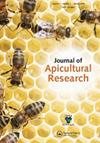Determination of volatile compound profiles and physico-chemical analysis of linden and acacia Czech honey
IF 1.8
4区 农林科学
Q2 ENTOMOLOGY
引用次数: 0
Abstract
Abstract In this study 12 acacia and 12 linden honey samples from the Czech Republic were analyzed with a chemometric and volatile compound profiles approach. The results of electrical conductivity (17.4 and 65.1 mS/m), free acidity (12.5 and 24.5 meq/kg), diastase activity (12.6 and 18.8 DN), colour (21.5 and 47.8 mm Pfund), hydroxymethylfurfural (HMF) (11.5 and 3.5 mg/kg), fructose (45.1 and 36.3 g/100g), fructose + glucose (F + G) (76.7 and 69.3 g/100g) content and fructose/glucose ratio (1.4 and 1.1) showed statistically significant differences (p < 0.05) between acacia and linden honey, respectively. The physico-chemical properties and pollen profiles were in compliance with the description of European monofloral honey, except for acacia honey due to the low proportion of acacia pollen (2.8 − 10.3%). According to volatile compounds analysis by head-space solid phase micro-extraction coupled with gas chromatography − mass spectrometry (HS-SPME/GC-MS), nine key volatile substances were selected from more than 100 volatile compounds present in the analysed samples for evaluation as markers of botanical origin typical of the most common plant nectar sources in the Czech Republic. Further, the non-targeted analysis combined with Principal Component Analysis (PCA) revealed trends and outliers within all chromatography data obtained for 24 honey samples. Cis-linalool oxide and β-linalool have been confirmed as markers of acacia honey, while carvacrol and p-cymenene were found almost exclusively in linden honey. The results demonstrated that the chemometrics with the non-targeted and targeted volatile compounds analysis approach is reliable and accurate for the classification of honey of various botanical origins.椴树和阿拉伯树胶捷克蜂蜜挥发性成分的测定及理化分析
摘要:本研究采用化学计量学和挥发性化合物分析方法,对来自捷克共和国的12种金合欢和12种椴树蜂蜜进行了分析。电导率(17.4和65.1 mS/m)、游离酸度(12.5和24.5 meq/kg)、淀粉酶活性(12.6和18.8 DN)、颜色(21.5和47.8 mm Pfund)、羟甲基糠醛(HMF)(11.5和3.5 mg/kg)、果糖(45.1和36.3 g/100g)、果糖+葡萄糖(F + g)(76.7和69.3 g/100g)含量和果糖/葡萄糖比(1.4和1.1)在金合花蜜和林蜜之间的差异均有统计学意义(p < 0.05)。除金合欢蜂蜜中金合欢花粉的比例较低(2.8 ~ 10.3%)外,其他理化性质和花粉谱均符合欧洲单花蜂蜜的描述。根据顶空固相微萃取和气相色谱-质谱联用(HS-SPME/GC-MS)挥发性化合物分析,从分析样品中存在的100多种挥发性化合物中选择了9种关键挥发性物质,作为捷克共和国最常见植物花蜜来源的典型植物来源标记。此外,非目标分析结合主成分分析(PCA)揭示了24个蜂蜜样品中所有色谱数据的趋势和异常值。顺式芳樟醇氧化物和β-芳樟醇已被证实是金合欢蜂蜜的标记物,而香芹酚和对丁香烯几乎只存在于椴树蜂蜜中。结果表明,化学计量学与非靶向和靶向挥发物分析方法对不同植物源蜂蜜的分类是可靠和准确的。
本文章由计算机程序翻译,如有差异,请以英文原文为准。
求助全文
约1分钟内获得全文
求助全文
来源期刊
CiteScore
4.80
自引率
10.50%
发文量
111
审稿时长
6-12 weeks
期刊介绍:
The Journal of Apicultural Research is a refereed scientific journal dedicated to bringing the best research on bees. The Journal of Apicultural Research publishes original research articles, original theoretical papers, notes, comments and authoritative reviews on scientific aspects of the biology, ecology, natural history, conservation and culture of all types of bee (superfamily Apoidea).

 求助内容:
求助内容: 应助结果提醒方式:
应助结果提醒方式:


